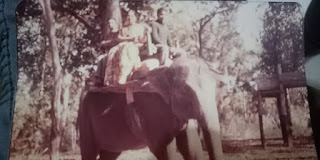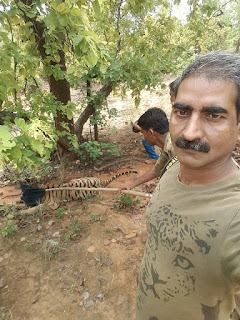One Starry Night in The Forest
The female must have been waiting to cross over the road whence my jeep intruded on the serene ambiance of the starry night. Thwarted by the strong headlights the disturbed leopard stood still peering into the ghostly darkness at the bizarre animal in the metal contraption.
My staff had whispered as we were negotiating the bend on the highway near Jabalpur my hometown.
"Shining Eyes Sir!"
It was eleven pm, and I was returning after a busy day purchasing tendu leaf from the Government godown at Kundam about forty km from Jabalpur in the hinterland. There are few places in urban India endowed with forests as good as Jabalpur...albeit losing ground fast due to intruding urbanization.
The reserve forests are losing crown cover here and hold a scarce prey base that supports few remaining leopards desperately surviving. I was also able to come across tigers mating here in the denuded confines of Baghraji Forests perhaps trying to revive their population coming to a definite end in this vanishing wilderness.
Upon notice by the staff, I brought my jeep to a halt and then reversed. "Point out where exactly you see the eyes reflecting." I switched out the headlights and waited for some time before moving towards the bush where the reflecting eyes were noticed. Pointing my jeep towards the bush I switched on my torch.
Not one but four pairs of eyes shone as I threw my torch around the bush. It was a female with three cubs about seven feet from us staring at the spectacle of humans in an open jeep. A few decades back this would have been a normal sighting but in these beleaguered times, this was a rare instance.
"She will get us!"
I was too engrossed in the spectacle to be cautious about the proximity. I could hear her warning coughs as I put the jeep in forward motion. The story had a sad ending, one of the cubs was poisoned a year after and another ended at a police station platform in broad daylight. The fate of the animals was not known thereafter.
 |
| Leopard Cub |
 |
| Leopard Female |
The Status
The status of leopards in India is on a steep decline. The drastic loss of habitat and the ensuing man-animal conflict is resulting in the endangerment of this beleaguered feline species. As per the recent news, more than a hundred leopards have been found dead in a spate of two months all over India. This is an alarming figure and the rot does not in any manner seems to stem.
The rapid decline of feline species speaks of our callous attitude towards wildlife and their habitats in general. The situation is further compounded by the colonial legacy which labeled wild animals as vermin especially the predators in India. Unfortunately, wildlife conservation finds only lip service in the country and no major policy decision takes into consideration the preservation of our heritage wilderness wealth.
The phenomenal diversity is fast disappearing now limited to protected areas and that too the ones receiving dedicated inputs. In vast countries a minuscule portion of land is subject to preservation, the rest is being exploited without any concern.
We live in an era that takes into account the well-being of one species only...that is us. Other life forms are shamefully neglected. Our news and political speak are only concerned with economic growth figures, welfare schemes, and rabid industrialization at cost of crucial natural resources and of course our health. Society has become so human-centered that we consider other life forms as unimportant and often a big nuisance.
The attitude will certainly result in warming, water scarcity, pollution, lack of productivity that sustains us, and chaos. Name it and you have it. Beware!
|
The image of predators as bloodthirsty rogues is permanently etched in our minds and that shapes our attitude. Albeit hunting is banned by the Wildlife Protection Act 1972, mass-scale lynching by humans on intruding leopards is a frequently occurring event. Poaching by electrification finds no solution and rising prices of wildlife products are an ever-looming threat the country faces.
The Vedas preached conservation in an ecosystem known as Hinduism in many thoughts originated and survives till today irrespective of extreme divergence. Why are we not following the sound principles preached by our ancestors as regards nature?
In the bygone era, wild animals including tigers and leopards lived in close proximity to human populations. The conflict was limited to one odd instance of a man killing in urban scapes... not anymore. Man-eating was due to advancing settlements and reducing prey base. All this good was due to ample forests/habitats prevailing before the denudation took place. Our greed for rabid urbanization, uncontrolled agriculture, and illicit wealth generation has taken a heavy toll on natural places all over and the disastrous practices continue. Human beings in any shape, size, and type have repeatedly shown extreme neglect of their surroundings affecting the health of the habitats and ecosystems prevailing they are in. There is hardly any inviolate space left for other life forms in our country.
The decline of wild animal populations started with bounty hunters and elite sport during the Raj, and the large-scale conversion of forests into agriculture fields not forgetting the ever-increasing settlements. Another age-old activity that has had far-reaching consequences was and is commercial forestry and wood logging.
Poaching has a substantial role in the large number of leopard deaths that take place every year. This sounds like a death knell for the feline species as the population is estimated below ten thousand all over the country.
Poaching and denudation is the major threat to our wilderness and strong protective mechanism and conservation practices are the need of the hour. The onus is on the Indian administration and politicians who shape our policies. But this does not keep the general population out of the loop. People's participation and awareness will go a long way to preserving or we will certainly lose our heritage.
Images By Suttons UK.













































